

Metal detecting holidays in England with the World's most successful metal detecting club.
Twinned with Midwest Historical Research Society USA
| 2012 March finds page |
 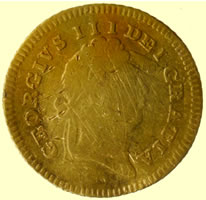 |
|||
| 1803 George III 1/3 gold guinea | |||
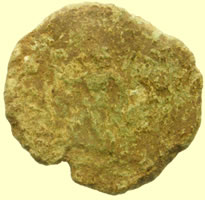 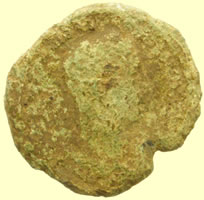 |
|||
| Huge Roman coin - sent for ID | |||
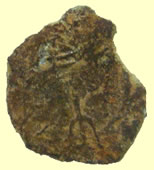 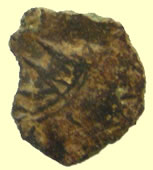 |
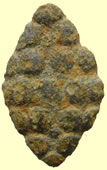 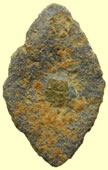 |
||
Mid 3thC Barbarous radiate Roman sent for ID Exactly as you describe it, except that these date to the mid-3rd and not the 4th century. This is typical of the locally-produced emergency coinages which popped up in Britain and Northern Gaul during the end of the Gallic Empire and the period of chaos which followed before Aurelian stitched the Empire back together. It held for another 200 years, although it came within a whisker of falling completely in the 260's-270's. The prototype here was probably an antoninianus of Tetricus II since this does not seem to be a bearded portrait. Mark |
Medieval mount | ||
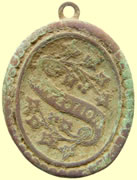 |
 |
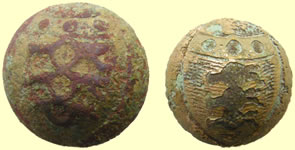 |
|
| 'Perfection' pendant | 16thC Tudor clothing fastener | 18thC Royal artillery buttons | |
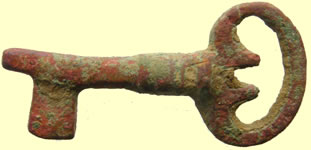 |
 |
||
| 15thC casket key | The Queens regiment badge | ||
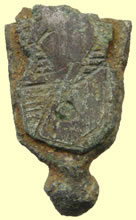 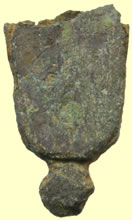 |
|||
| Stunning decorated medieval knopped strap end | |||
 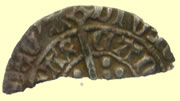 |
  |
||
1485 -1509 Henry VIII hammered silver groat Obv *** DI GRA Rev CIVI/TAS/CAN/TOR - Canterbury mint |
1199 John hammered silver half penny - Class 5 Obv HENICVS REX Rev ** AN ON W** - Moneyer Iohan of Winchester mint |
||
 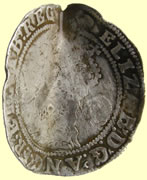 |
 |
||
| 1591 Elizabeth 1st hammered silver sixpence | 18thC musket ram rod guide | ||
 |
 |
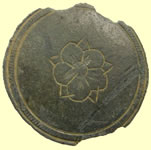 |
|
| Georgian period operating gilded arm ? | Georgian fob seal holder | 18thC Royal navy button | |
  |
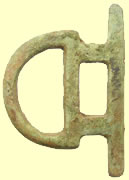 |
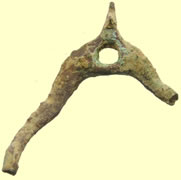 |
|
| 1500-1700 mount | 19thC harness bucl;e | Saxon period gilded item - not sure of use yet | |
|
 |
|
|
| c10thC Saxon harness fragment | Medieval pot leg | 19thC Customs button |
|
 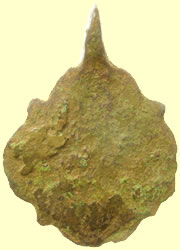 |
|||
Stunning medieval heraldic pendant - two silvered eagle heads facing outwards on red enamel - griffin in blue square enamelled back ground Researching the titled family |
|||
 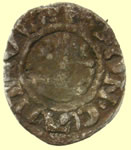 |
  |
||
1189-1190 Richard 1st hammered silver voided short cross hammered silver penny Class 2 ('cooking' to remove horn silver crust ) Obv HENRICVS REX Rev VLARD ON CANT - Moneyer Vlard of Canterbury mint |
Taco'd 1208-9 John hammered silver voided short cross hammered silver penny Class 6 Obv HENRICVS REX |
||
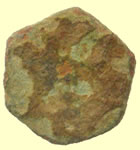 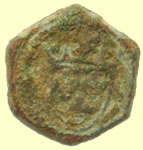 |
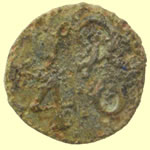 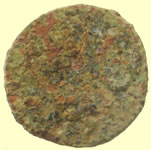 |
||
1475 French uniface gold 'ecu au soleil' coin weight - Hexagonal French issue with sun above 3 lis in a shield
|
1770's 4 shillings and 6 pence coin weight 9 54 pence) Obv 4S 6D |
||
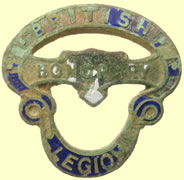 |
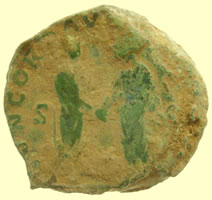 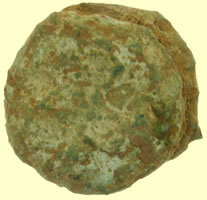 |
||
| 20thC British legion badge | Great find, 2 - 2ndC Roman bronzes stuck together Quite a mess - interesting, however. The reverse places and dates at least that one coin quite well. That's the "Concord Augustor" reverse showing Marcus Aurelius and his son-in-law and co-emperor Lucius Verus clasping hands. This was probably meant to instill faith in the two-emperor setup and/or Lucius Verus who was rather well known for his epicurean excesses. David Sear puts the situation this way: "...Verus...was the son of Aelius Caesar (Hadrian's chosen successor who pre-deceased him) In 138 he was adopted by Antoninus, but unlike M. Aurelius... adopted at the same time, he was not raised to the rank of Caesar. Nevertheless, on the accession of Aurelius in 161 AD, Verus was immediately made co-emperor. He was also ...[married] to Aurelius' daughter Lucilla in 164 AD. He campaigned in the East from 163-5 with considerable success, but he was a weak man addicted to pleasure and his death in 169 was a relief to his partner." In 161 when Antoninus Pius died and the then middle-aged Marcus Aurelius Caesar became Augustus this reverse was struck on all the Æ denominations (and most of the AR & AV denominations as well) of both emperors. Marcus Aurelius had actually been Caesar under Antoninus Pius for a little longer than he was to be emperor in his own right. The Concord Augustor reverse on a sestertius: http://www.stoa.org/gallery/album94/M_Aurel_2 Mark |
||
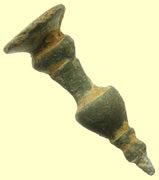 |
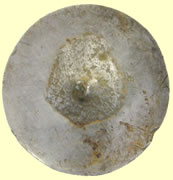 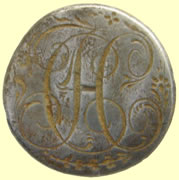 |
||
| 16thC Tudor seal spoon handle | Superb Georgian silver monogrammed button | ||
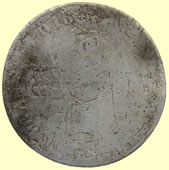 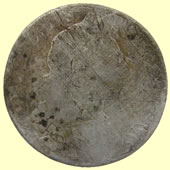 |
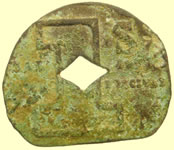 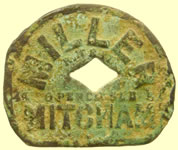 |
||
| 1696 William III milled silver shilling |
20thC Miller 1 shilling traders token 48 Opencastle Mitcham |
||
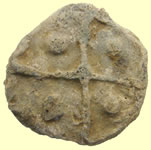 |
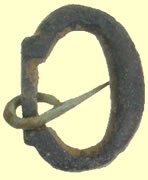 |
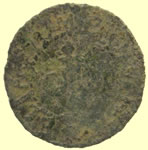 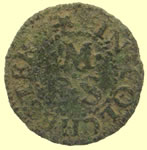 |
|
| 15thC lead token - type 2 | Medieval D buckle | 17th Elias Moortier of Colchster Essex hammered copper trade farthing Norweb Part II 1207b |
|
 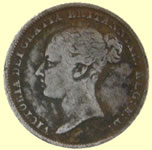 |
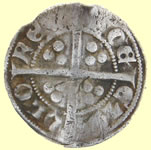 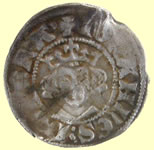 |
||
| 1845 Victoria milled silver sixpence | Medieval hammered silver penny - Continental imitation , E(a) Sterling type Obv IOHANNES DEI GRA Rev REX/BOE/ETP/OLO Matthew No 257 |
||
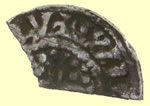  |
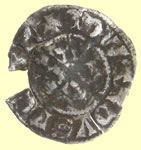 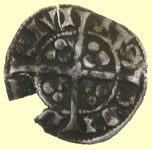 |
||
1180 Henry 1st hammered silver half penny Obv HENRICVS REX Rev **V+ WILL ** Moneyer Willelm of London mint |
1314 Edward III hammered silver half penny - type 12 Obv EDWARDVS REX Rev CIVI/TAS/LON/DON- London mint 0.52g, 14.77mm |
||
|
|||
| C1000 BC Bronze Age decorated sword blade fragment | |||
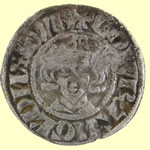 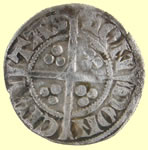 |
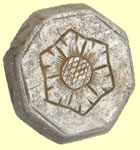 |
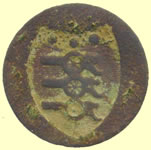 |
|
1341 Edward III hammered silver florin penny - Cross 3 Obv EDWAR ANGL DNS HYB Rev CIVI/TAS/LON/DON |
18thC silver button | 18thC Royal artillery button | |
 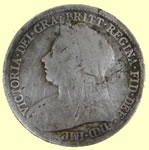 |
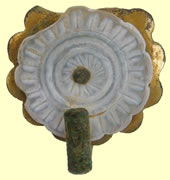 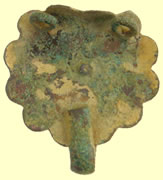 |
||
| 1901 Victoria milled silver six pence | Georgian gilded hooked clasp | ||
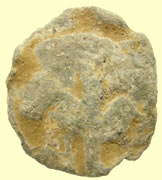 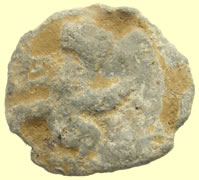 |
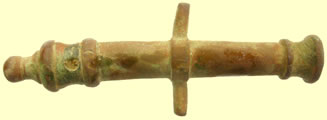 |
||
| Excellent medieval lead token - bear bating sceens both sides | 18thC toy cannon | ||
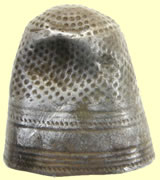 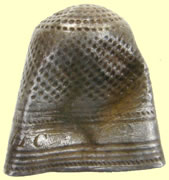 |
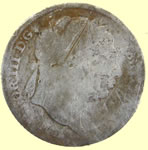 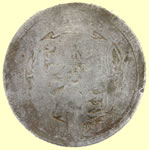 |
||
| 18thC silver thimble - monogrammed HC | 1816 George III milled silver sixpence | ||
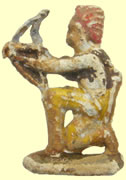 |
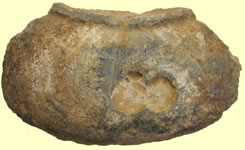 |
||
| Neat Indian lead toy | 18thC lead sewing palm guard | ||
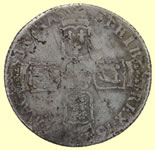 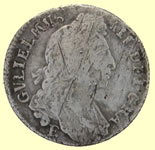 |
  |
||
| 1696 William III milled silver shilling - Exeter Mint | C8thC Saxon bow brooch | ||
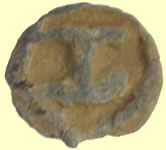 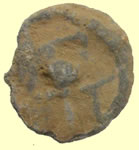 |
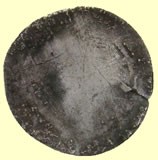 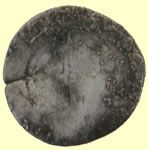 |
||
| 17thC lead trade token | 16thC C Elizabeth 1st hammered silver half groat | ||
Medeival pin head |
16thC Tudor pin head |
||
 |
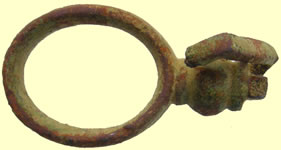 |
||
| Medieval thumb ring - stirrup style | 17thC sword hanger | ||
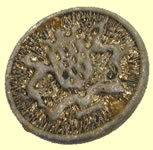 |
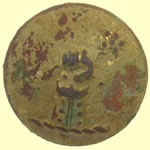 |
||
| Corporation button | 19thC livery button | ||
C1000 BC Bronze Age sword blade fragment |
|||
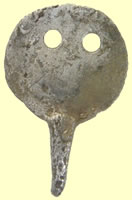 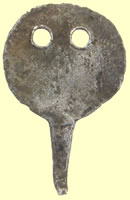 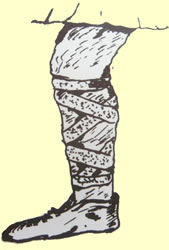 |
|||
Staggeringly rare find - c8thC Saxon solid silver hooked fastener used on their leg bindings Reported as treasure to museum
|
|||
|
|||
| Very interesting Roman dagger pommel with circle decoration on handle - appears to be broken during battle | |||
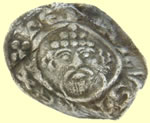 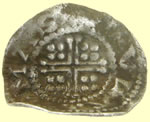 |
|||
Brilliant find and our first ever Rhuddlan (Welsh) mint found - Cross is Cross pattee, a cross with pellet ends 1180 Henry II hammered silver short cross penny - Group 1 coin Obv HENRICVS REX Rev + TOMAS ON RVLA - Tomas of Rhuddlan mint (wales) |
|||
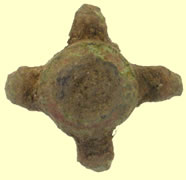 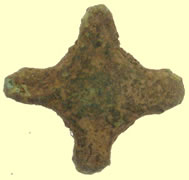 |
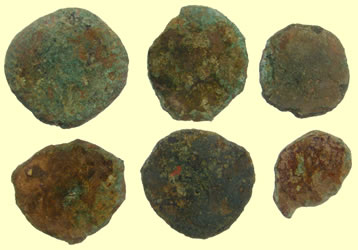 |
||
| C10thC Saxon terminal divider | Roman 2nd C 'grots' off new land | ||
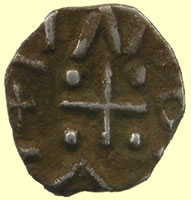 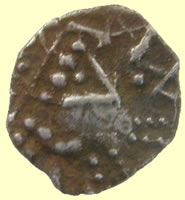 |
|||
Primary Saxon silver sceat - 600-775 AD sent to Fitzswilliam museum for recording and ID Obv Pointed nose face, bust facing right Many thanks for this new coin, which I have recorded as EMC 2012.0101. Best wishes, Martin
|
|||
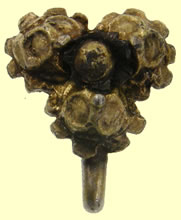 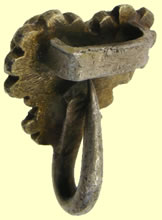 |
|||
| Stunning 16thC Tudor hooked fastener - gold on silver reported to museum as treasure | |||
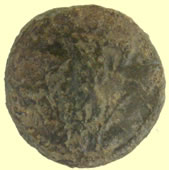 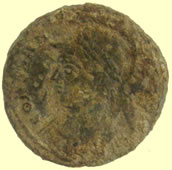 |
  |
||
4thC Roman bronze coin sent for ID If you will recall the paragraph I wrote recently on the VRBS ROMA / Shewolf type, this is one of the CONSTANTINOPOLIS / Victory-on-prow companion types - the two city commemoratives of 330-335 for both Constantine's new capitol at Constantinople and the Eternal City (so those Romans wouldn't feel too slighted by the move). Mark |
1464-5 Edward IV hammered silver half penny - light issue - Trefoil by neck - Type X Obv ** REX ANGL Rev CIVI/TASLOND/DON - London mint |
||
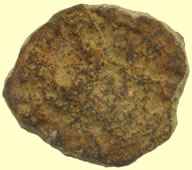 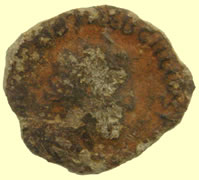 |
|||
Debased silver Roman coin sent for ID - soaking to clean it more as 'cooking' could damage it
20.75mm This piece presents a couple of problems. Generally speaking, it appears to be either an official or reasonably well-done unofficial piece for Tetricus I, whose portrait appears to be on the obverse - generally speaking, this is none too unusual, as you're probably aware. Unofficial (and official) Tetricus radiates are found all over Britain all the time. 1st problem - the legend, although at first glance it seems to be "literate", it doesn't line up with any known legend on a radiate of this period - and I'm talking about everyone including the issuers of post-reform radiates after Diocletian's reforms - ie: the previous 15 and the next 30 years, at minimum, from Tetricus' time. OK, there were plenty of "imaginative" legends placed on unoffically produced coins, up to and including the lettering becoming a merely decorative border of "I's" and "O's", etc. But this is tantalizingly close to looking like it should be a legit legend. 2nd problem - the reverse - and as you can tell, there isn't a lot to go on - seems to be of the CONSECRATIO / lighted altar enclosure with panelled front. These are exceedingly common for Claudius II, Gothicus, but the legend on the obverse is nothing like any legend ever seen on a Gothicus posthumous piece. There were no posthumous issues for Tetricus - he was rewarded for giving up the Gallic Empire to Aurelian without a fight, retired into private life and died in bed in a villa in Italy an unknown length of time afterwards as he disappears from the historical record at that point. I'm stuck with saying that it's a contemporary copy of the so-called "barbarous radiate" type, emulating a prototype - a very common posthumous issue of Claudius II (with a portrait that favors Tetricus I) - except that instead of copying the simple DIVO CLAVDIO or any of Tetricus' legends, the diecutter went wild and made up a 25 or 30 character obverse legend - typically unofficial diecutters shortened and simplified legends - they didn't make them longer and more involved, particularly when making them look as though they were a literate and legitimate legend. For those reasons, this is one of the most unusual radiates of this period I have ever seen. Mark
|
|||
|
|||
| 850 BC Bronze age socketed axe head -101.9 mm long | |||
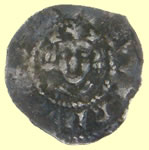 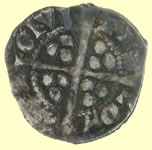 |
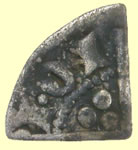 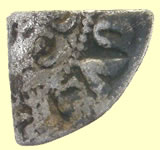 |
||
1300 Edward 1st hammered silver farthing- type 28 Obv EDWARDVS REX Rev CIVI/TAS/LON/DON - London mint |
1247 Henry III hammered silver voided long cross farthing | ||
 |
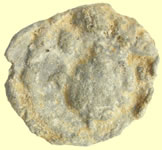 |
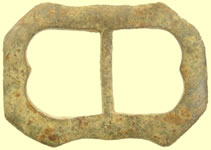 |
|
EYC 20th Regiment of foot ?? |
Roman lead token | 17thC buckle | |
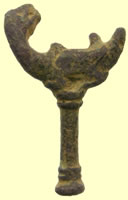 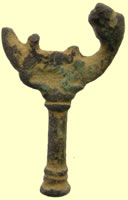 |
|||
| Early 17thC pipe tamper - winged dragon | |||
 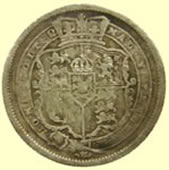 |
 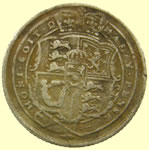 |
||
| 1817 George III milled silver shilling (12 pence) | 1818 George III milled silver six pence | ||
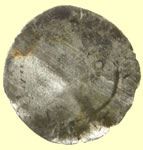 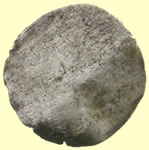 |
 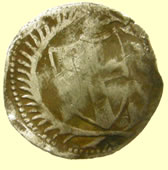 |
||
| 16thC Elizabeth 1st hammered silver penny | 1649 Commonwealth hammered silver half groat | ||
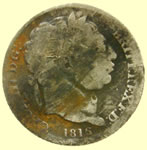 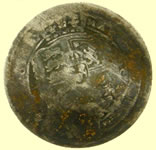 |
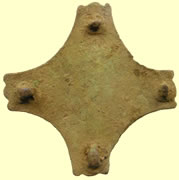 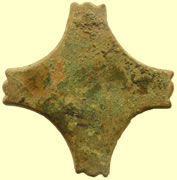 |
||
| 1816 George III milled silver six pence | 1500-1700 mount with 4 integral lugs | ||
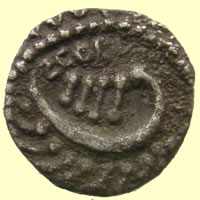 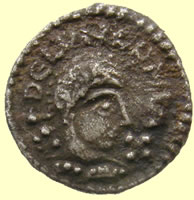 |
|||
Stunning Primary Saxon silver sceat - 600-775 AD sent to Fitzswilliam museum for recording and ID 1.13mm, 12.55mm
This coin (EMC 2012.0103) is a good example of the MONITASCORVM group, which is certainly very interesting. Some coins with a similar portrait read MONITASCORVM, which probably means 'money of the saints' (MONITA S[AN]C[T]ORVM), and there are other coins that clearly state that they are from London: DE LVNODNIA, some of which (as here) have SCORVM on the reverse under the 'porcupine'. The most likely (but still speculative) explanation of these inscriptions is that this is a coinage of the bishops of London. Best wishes, Martin |
|||
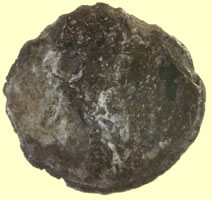 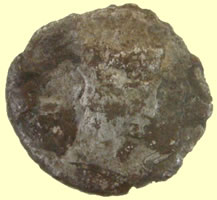 |
|||
Crusty Roman silver sent for ID I'll have to meditate on this one a bit. It ultimately may not be possible to ID it with any certainty, but at the moment, I don't have even a glimmer of immediate recognition. Mark |
|||
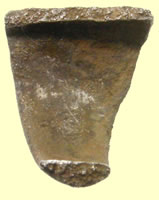 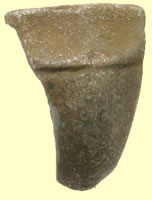 |
|||
Tricky find as this could even at a pinch be Saxon period, probably 2ndC Roman silver fibular brooch fragment - reported as treasure to museum Can't 'cook' it to remove horn silver crust unless disclaimed by British Musuem first |
|||
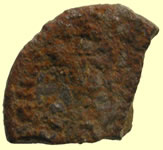 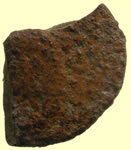 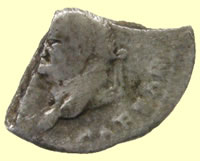 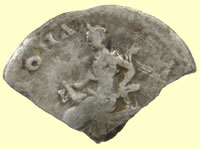 |
|||
Amazing detail after 'cooking' on this crusty Roman silver fragment - sent off for ID Checking my references for the Flavians, this type - ANNONA AVG. Annona enthroned left holding a bag of corn-ears in her lap - was struck for both Vespasian and Titus as Caesar in 78/9 AD. Both used legends which would put the word CAESAR in the position in which it's visible on the obverse. If you can detect any trace of a "T" before the CAESAR, then it would be Titus. If you believe there is nothing at all before the CAESAR, then it is Vespasian. Titus : T CAESAR VESPASIANVS So I can't be 100% certain for whom it was struck (I think it's Vespasian) but the date and everything else would be the same except for a single letter in the obverse legend, and, of course, whether the bust was intended to portray father or son. It's not possible at this point to be certain, but it is quite possible that this piece was at least halved in antiquity, in order to make change - perhaps even quartered, although the upper, curved break seems more likely to be accidental while the lower one looks more as though it was made with a chisel or other blade. Mark |
|||
Ad dug
'Cooking'
Just about 'cooked'
|
|||
2ndC Roman silver - straight into the 'cooker' to remove horn silver crust - R Hadrian (117-138 DA) with Victory on the reverse. A more detailed ID will have to wait for more legend to be revealed. Mark I stand with my original identification - Hadrian / Victory - but there are a few things I can add, now. The obverse legend is IMP CAESAR TRAIAN HADRIANVS AVG - quoting his official name which contains the name of his predecessor and adoptive father, Trajan. The legend on the reverse is P M TR P COS III meaning Pontifex Maximum (head of the state religion) holder of the Tribunician Powers (ie: leader of the Plebeans as well as the Aristocracy) Consul for the 3rd time. This allows us to date this piece. Although Hadrian (117-138 AD) was consul only 3 times with his 3rd consulship coming very early in his reign, he was eligible to use "COS III" at any time after the fact - so that only brings the spread down to 119-138 AD. Not too much help in and of itself. However, this particular use of his list of titles dates specifically to the earlier part of his reign, c. 119 - 125 AD. This particular type is part of the series issued specifically in 123 AD. The reverse of this piece probably refers to a specific military victory rather than to "Victory" as an allegorical personification of an abstract virtue. I don't know Hadrian's history well enough, however, to tell you what campaign or battle this might be commemorating. Mark |
|||
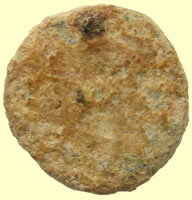 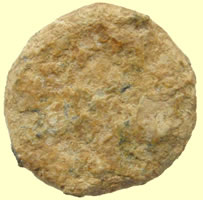 |
|||
| Very unusual growth on this 2ndC Roman silver - straight into the 'cooker' to remove horn silver crust - B | |||
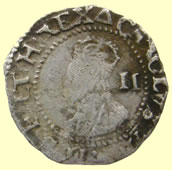 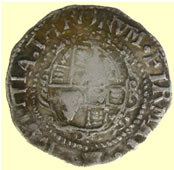 |
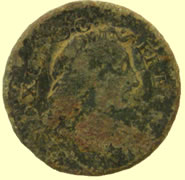 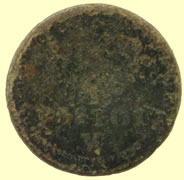 |
||
| 1639-40 Charles 1st hammered silver half groat - Triangle mintmark | Louis XIV 1643-1715 British made coin weight for the Louis d'or, known in England as apistol or Pistole Rev 1 PISTOL W |
||
|
|||
2ndC Roman silver - straight into the 'cooker' to remove horn silver crust - S On the strength of the portrait I'm willing to say that I'm almost positive that this is a denarius of Trajan (96-117 AD) and if so, this style of portrait tended only to be used relatively early in his reign (c. 96-100 AD). I don't think I'll be able to tell you much more on the basis of the seated figure on the reverse. The nearly complete lack of legend on both sides - what little is visible is not of any help - will probably prevent me from making a positive ID. I don't know which personification or deity this is supposed to be. I'll have a quick look through a list of types, but I rather suspect that there will be more than one which vaguely fits this description. The one thing we have in our favor for a closer ID is that a figure seated to the right is somwhat unusual, most will face left. The objects she is holding - a scepter and olive-branch (I think) - usually are Pax's attributes Mark |
|||
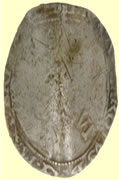 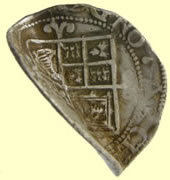 |
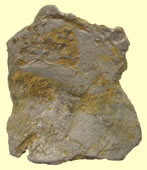 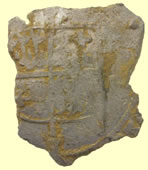 |
||
| 1639-40 Charles 1st hammered silver sixpence - Triangle mintmark | 1547-51 Henry VIII hammered silver groat - posthumous issue |
||
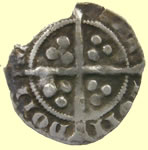 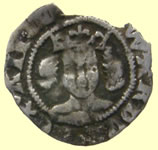 |
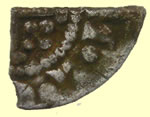 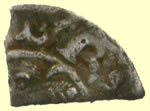 |
||
1356-1361 Edward III hammered silver penny - Pre treaty series G, annulet stops Obv EDWARDVS REX ANGLI Rev CIVI/TAS/LON/DON - London mint |
1247 Henry III hammered silver voided long cross qtr penny Obv HENRICVS REX Rev * RAN/** Moneyer Randvlf - Bury St Edmunds mint |
||
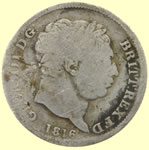 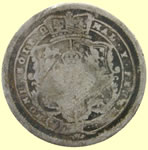 |
 |
||
| 1818 George III milled silver six pence | Victorian silver brooch | ||
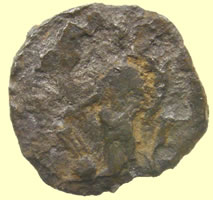 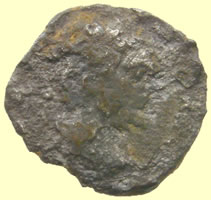 |
|||
Wierd silver Roman laminating badly as dug - sent off for ID 16.59mm, 1.42mm Although in this shape with no remaining legends and a deteriorated portrait, about all I can do is make an educated guess. I believe this is most likely Trajan - 96-117 AD - and the reverse type, which is clear enough to be certain about, is Fortuna. She's depicted standing left holding a rudder and cornucopiae. Fortuna was one of those "evergreen" reverse types, like Pax, and might turn up on the reverses of virtually anyone from the first 3 centuries of the Empire. Mark |
|||
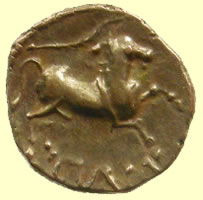 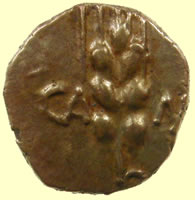 |
|||
| 10-40 AD Cunobelin Celtic gold qtr stater - 11.89mm,1.22g | |||
Ad dug
Cooking Please let me see this when it gets a bit cleaner - I believe it is Magnentius, a short-lived usurper in the West, 350-353. His silver is pretty rare. This is the same fellow a lot of whose Centenionales you found and had to declare as a hoard last year or the year before. Are you certain this is silver? This type is quite common in Æ, but this is a very, very rare type in AR - and in fact, this would be an unpublished variety of Light Miliarense or a formerly completely unknown type of Siliqua (if it is silver and it is Magnentius). Mark
|
|||
| 2ndC Roman silver - straight into the 'cooker' to remove horn silver crust - NB | |||
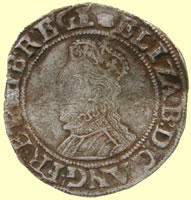 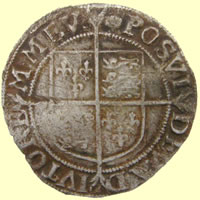 |
|||
| 1592-5 Elizabeth 1st hammered silver shilling - Tun mint mark | |||
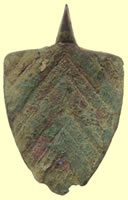 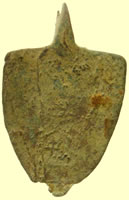 |
 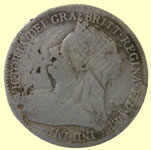 |
||
| 13thC Heraldic shield pendant | 1894 Victoria milled silver sixpence | ||
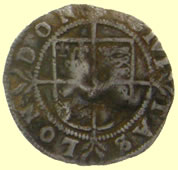 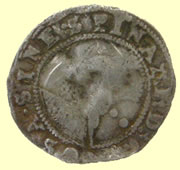 |
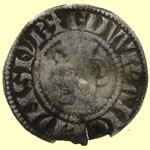 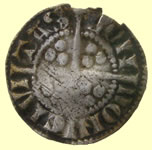 |
||
| 1582-4 Elizabeth 1st hammered silver half groat - A mint mark | 1341 Edward III hammered silver florin penny Obv EDWR ANGLE dNS HYB Rev CIVI/TAS/LON/DON - London mint |
||
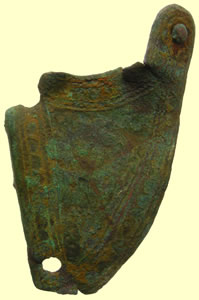 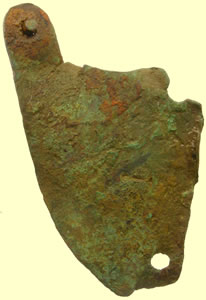 |
|||
C4th to 8thC Decorated and gilded helmet cheek piece - could be Roman or Saxon - checking ref books 75.02mm L |
|||
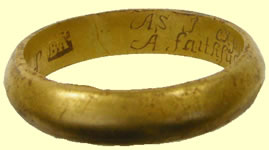 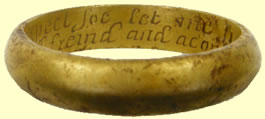 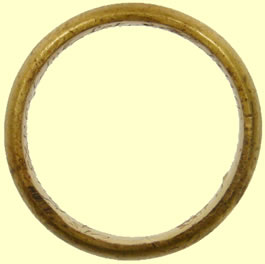 |
|||
Stunning 17th/18thC gold posy ring - reported as treasure to museum 21.85mm,6.73g Brilliant misspelled inscription 'AS I EXPECT SOE LET ME FIND 'A FAITHFUL FREIND AND A CONSTANT MIND' |
|||
10-40 AD Cunobelin Celtic gold qtr stater - Linear type 11.55mm, 1.33g |
|||
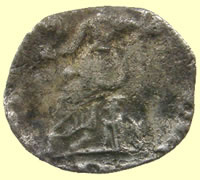 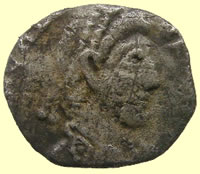 |
|||
4th/5thC Roman silver coin sent for ID Yes, it looks like one of the officially clipped siliquae created to agree with the size and weight for use as Sceattas. There seems to be just enough of the bottoms of the letters on the left for me to say that I have a strong suspicion it's Valens - 364-378 AD. If it is Valens, as I suspect it is, this VRBS ROMA reverse was struck with longer mint marks at only 4 mints - Trier, Lugdunum, Aquilea and Siscia. Rome struck it too, but with only 2 characters in the mint mark. I can't be quite as sure about making a determination of the mint mark from a few random serifs as I think I can for the obverse legend, but based on what seems to be the centering of the mint mark, I believe it's more likely to consist of 6 characters than 4, meaning it's more likely to be from Siscia than any of the other 3 which used 4-character mint marks. Mark |
|||
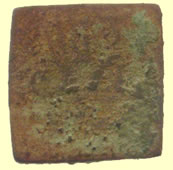 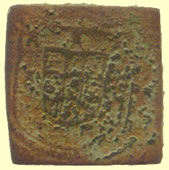 |
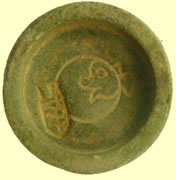 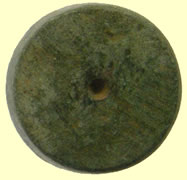 |
||
| 1564-1604 Antwerp hand coin weight - Cornelis Janssen | 1830's - trade weight - London mark | ||
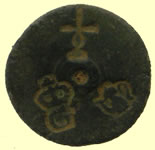 |
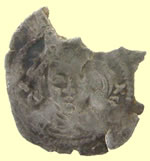 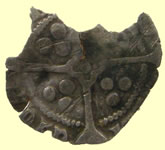 |
||
| George II trade weight - Crown G cipher | 1427-1430 Henry VI hammered silver penny - Rosette-Mascle York issue Quadrefoil with dot at centre of reverse cross Rev CIVI/TAS/EBO/RACI |
||
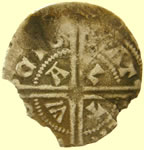 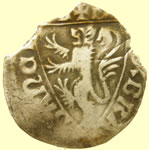 |
|||
Continental hammered silver penny - researching it BRABANT. Jean I, 1268-1294 AD. AR Esterlin (1.10 gm) of Antwerp. Shield of arms / Voided cross, WALT. VanG.160. dW.242. . |
|||
  |
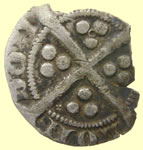 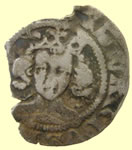 |
||
| 1495 -8 Henry VIII hammered silver groat | Unknown 1351- 1361 Pre treaty Edward III hammered silver penny - annulet in centre of pellets in one quadrant - should be Durham mint but this is London Obv EDWARDVS REX *** Rev CIVI/TAS/LON/DON - London mint
|
||
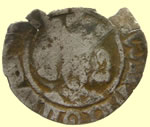 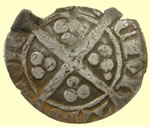 |
 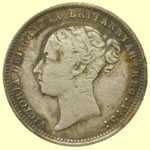 |
||
1341 Edward III hammered silver florin penny Obv EDWAR ANGLE DNS HYB Rev CIVI/TAS/LON/DON - London mint |
1871 Victoria milled silver sixpence | ||
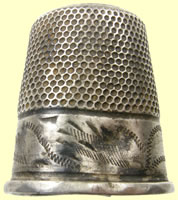 |
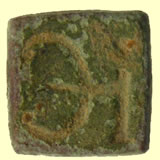 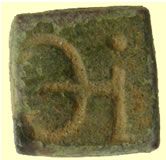 |
||
| Georgian silver thimble | 17thC apothecary weight | ||
 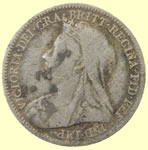 |
 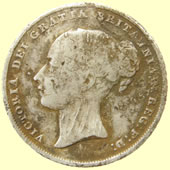 |
||
| 1900 Victoria milled silver sixpence | 1856 Victoria milled silver shilling (12 pence) | ||
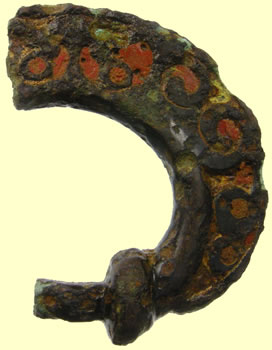 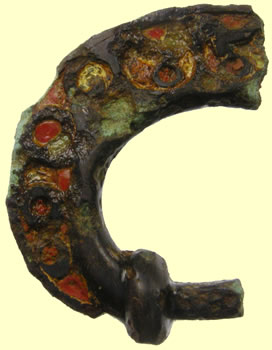 |
|||
Monster find Romano/British Chariot top Terret ring - this is enormous with gold, red enamelled 65mm high |
|||
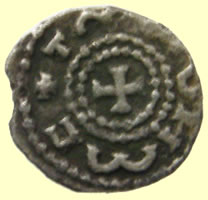  |
|||
Stunning Primary Saxon silver sceat - 600-775 AD sent to Fitzswilliam museum for recording and ID 11.53mm1.12g This new find (EMC 2012.0106) is a good example of a late phase of the Vanimundus coinage (VaBII). Along with the Pada type, Vanimundus marks the transition from gold to silver coinage in the 670s/680s. Early coins in VaA are gold but late coins in VaBII are of silver with perhaps a small amount of gold. Dr Martin Allen
|
|||
Early Bronze Age and early Middle Bronze Age, c. 1600-1300 BC. Bronze Age chisel 99.9mm L x 16.9mm W
|
|||
 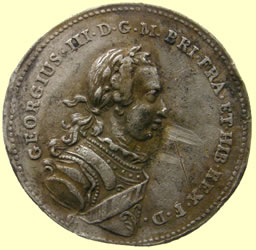 |
|||
Huge crown sized silver 1760 George III coronation medallion George III , the official silver medal for the coronation, 1761, by L. Natter, laur. and armoured bust r., variety with thinner bust with longer face, rev. King enthroned, crowned by standing Britannia, PATRIAE. OVANTI , normal Latin date MDCCLXI , 34mm. (Eimer 694; BHM 23A) |
|||
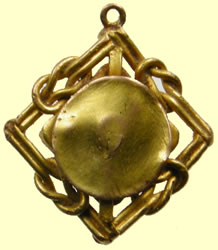 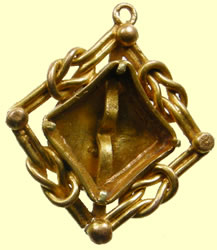 |
|||
Stunning pure gold pendant - twister wire is Roman style and the knops are Tudor but the missing stone fittings a look Georgian. At guess I would say 16th/17thC - reported to Colchester museum as treasure and their experts will ID 1.45g, 14.72mm
|
|||
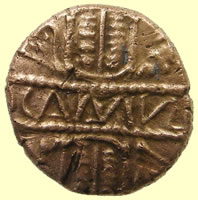 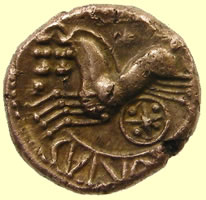 |
|||
10-40 AD Cunobelin Celtic gold full stater - very rare bigga type
5.51g, 16.86 |
|||
  |
|||
| Needs a clean as this is a Georgian silver seal matric with a heraldic crest on the back - JP | |||
  |
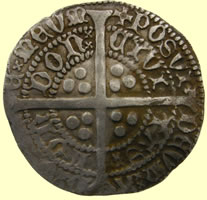 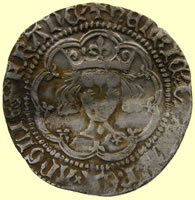 |
||
1215 Henry III hammered silver short cross half penny Obv HENRICVS REX Obv **ON.LVND - London mint |
1427 - 1430 Henry VI hammered silver groat- Rosette Mascle issue - T in TAS struck over I - Cross type 2 Obv +HENRIC DI ANGLE FRANC Rev CIVI/TAS/LON/DON - London mint |
||
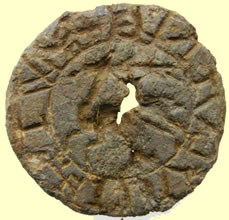 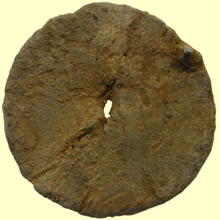 |
|||
Huge C13thC lead seal matrix - dragon facing left Not checked legend yet |
|||
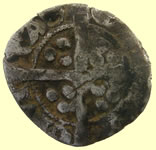 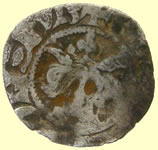 |
 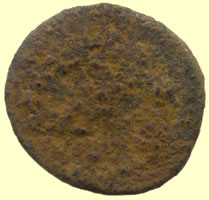 |
||
1279 Edward 1st hammered silver penny - Cross Potent Obv ED ***** DNS HYB Obv CICI/TAS/EBO/RACI - York mint |
Roman silver coin - straight in to 'cooker' | ||
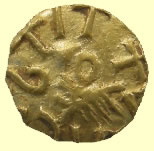 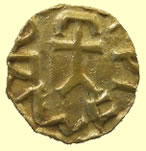 |
|||
Merovingian tremissis of the 7th century Saxon gold coin - this is part of an existing hoard and reported as hoard to the museum Sent to Fitzwilliam museum for ID and recording This sucker is tiny and mint 1.30g, 10.21mm, totally different from the others Many thanks. A preliminary trawl of the works of reference has not yet I have not recorded this in EMC as it is probably not a single find. Best wishes, Martin
|
|||
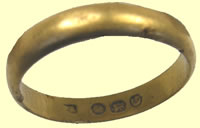 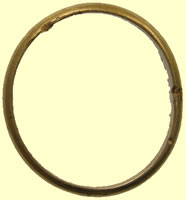 |
|||
Gold ring with full set of hall marks- London 1942 - Maker *B 2.91g,19.33mm |
|||
1stC Celtic silver unit - straight into the 'cooker' to remove the horn crust Cunobelin 20 AD Celtic silver coin The Cunobelin silver is very nice, and a rare type at that. Seated figure facing left. The only standard reference for the type is no. 308 in Spink's Coins of England, it's not in Van Arsdell or the BM catalogue. You can see the amphora which the seated figure is holding quite clearly, but the CVNOBE doesn't show up too well on either. I don't have the exact figures here for rarity, but I don't think there are more than a dozen of these recorded at most. Date is perhaps somewhere in the middle of Cunobelin's reign, say perhaps c. 20-25 AD. |
|||
As dug
Cleaned
|
|||
8thC Saxon Offa Rex silver penny - in 'cooker' to remove crust sent to Fitzwilliam museum for ID and recording Different type pf the other we have found 16.22mm,1.31g
The images of this new coin (EMC 2012.0110) are good enough to see that this is from the same dies as three of the five specimens of this type in Derek Chick's The Coinage of Offa and his Contemporaries (Chick 31c-31e). It may well look magnificent once it is cleaned. Best wishes, Martin |
|||
  |
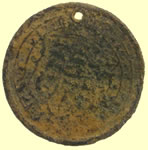  |
||
1341 Edward III hammered silver florin penny Obv EDWAR ANGLE DNS HYB Rev CIVI/TAS/LON/DON - London mint |
1816 George III milled silver forgery | ||
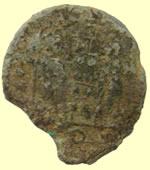 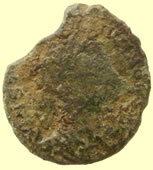 |
 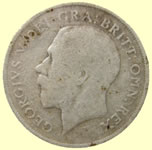 |
||
| Mid 4thC House of Constantine Roman bronze coin - 2 soldiers standing | 1922 George V millled silver shilling | ||
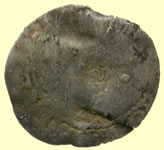 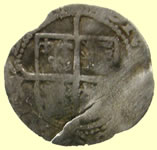 |
 |
 |
|
| 16thC Elizabeth 1st hammered silver penny | Junior Thames Yacht club | Napoleonic period Loyal Colchester Volunteers button | |
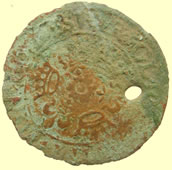 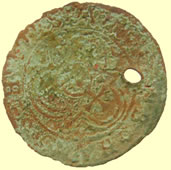 |
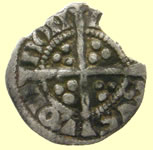  |
||
1586 Hans Krauwincel II Rose orb Jeton HANNS KRAVWINCKEL IN NVRENB |
1299-1300 Edward III hammered silver farthing - Type 9 Obv +ER AN GLIE Rev LON/DON/IEN/SIS |
||
 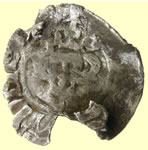 |
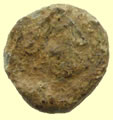 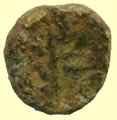 |
||
1341 Edward III hammered silver florin penny - Cross 3 Obv EDWAR ANGLE DNS HYB Rev CIVI/TAS/LON/DON - London mint |
Tiny Roman minim Roman bronze - sent for ID This appears to be one of the 4th/5th century copies of Constantinian-era types. I'm not certain which type was intended here (a little cleaning might make the reerse a little clearer) but those most often used as prototypes were the GLORIA EXERCITVS Soldiers and standard(s) types and the FEL TEMP REPARATIO - Soldier spearing fallen horseman type. As the Roman administration first began "thinning-out" and eventually left the island altogether, "well-civilized" - ie: Romanized - areas tended to continue producing their own coins to attempt to continue or revive the trade of the Roman era. Eventually the feudal economic system replaced all free-market trade and small-change coins were no longer necessary. There were no longer any good to be bought by folks - nor did anyone but the top echelons of society have the freedom or wealth to make this possible or necessary. These minims represent the brave attempts of the last few outposts of the old civilization in holding-out as long as they could against the chaos which filled the power-vacuum left by the Roman administration in abandoning the island. Mark |
||
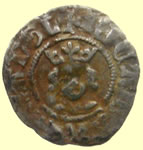 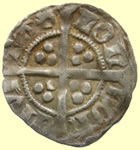 |
  |
||
1377-1399 Richard II hammered silver half penny - type b(i) Obv +RICHARD REX ANGL Rev CIVI/TAS/LON/DON - London mint |
Large Roman As sized coin sent for ID On the basis of first glance at the head portion of the bust, I'd have said a Flavian - Vespasian, Titus, young Domitian, all were portrayed with the chipmunk-cheeks, but also with a short, bull-like neck. This portrait has a long neck - rather like the portrait of Claudius - whose face is nothing at all like this face. I'm going to say that I believe the apparent shape of the face and head is probably distorted by corrosion and encrustation, and if one pulls the nose back a bit and deflates the apparently swollen cheeks, it begins to look a lot like Trajan - 96-117 AD. Mark |
||
|
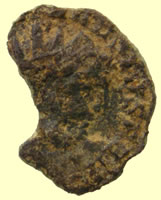 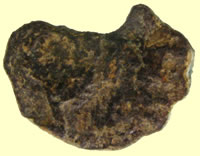 |
||
| Gilded Georgian shaped buckle fragment with Saxon type gilding ? | Roman silver coin - 'cooking to remove crust | ||
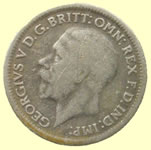 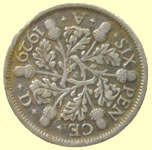 |
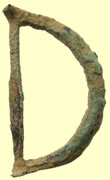 |
||
| 1929 George V milled silver sixpence | Medieval annular buckle | ||
  |
|||
Merovingian tremissis of the 7th century Saxon gold coin - this is part of an existing hoard and reported as hoard to the museum Sent to Fitzwilliam museum for ID and recording 1.18g, 11.73mm |
|||
As dug
Cooked
|
|||
This is in fantastic shape out of the ground and silver from the late centuries is hard to find - 'cooking' it to clean up the detail Just sent it off for ID 16.99mm,1.16 This one pretty much has to be Julian II, but so far I have been unable to find this precise combination of obverse and reverse in RSC - I'm not all that familiar with volume V of RSC since all the later silver (mostly Siliquae) is an order or three of magnitude more rare, in general, than the silver Denarii and Antoniniani of earlier centuries. I need to dig in the listings a bit more to confirm what I think about which emperor it is, but this is a Siliqua from the mint in Lyon France, then known as Lugdunum. After a bit more work, this seems to be an unpublished variety of obverse legend for Julian for this type (VOTIS / V / MVLTIS / X) at Lugdunum. I need to dig around a little more, but it's looking very like this is the case, since RIC VIII seems to agree with RSC V that this combination of legend and reverse type hasn't formerly been recorded. Mark |
|||
 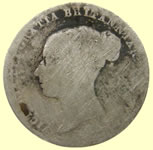 |
 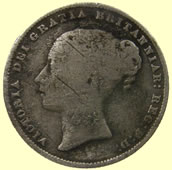 |
||
| 19thC Victoria milled silver sixpence | 1859 Victoria milled silver shilling | ||
 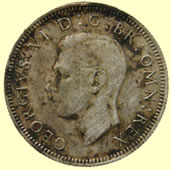 |
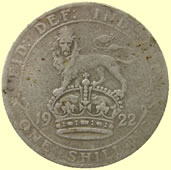 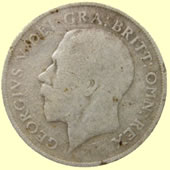 |
||
| 1944 George VI milled silver shilling | 1922 George V milled silver shilling | ||
  |
|||
| Georgian pipe tamper - mother and child | |||
 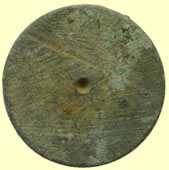 |
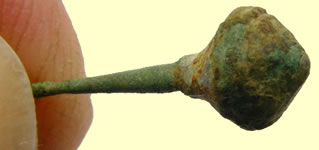 |
||
| George II trade weight - Crown G cipher London | Saxon pin | ||
 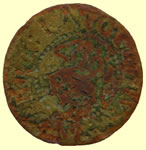 |
 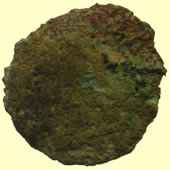 |
||
| 1667 Albra Langley of Colchester Essex hammered copper trade farthing | English medieval Edward jetton | ||
  |
  |
||
| 1560-1 Elizabeth 1st hammered silver penny - Martlet min mark | Taco'd 1634 Charles 1st hammered silver sixpence | ||
'cooked'
|
|||
2ndC Roman silver coin sent off for ID This is another of the so-called "Tribute Pennies" - a denarius of Tiberius - he struck basically only this one type of denarius throughout his entire long (24 year!) reign between 14 & 37 AD. The reverse is PONTIF MAXIM - referring to Tiberius' position as the head of the State religion, and the seated figure is generally accepted to be his mother, Livia. If not, it's some generic personification - there are a couple theories which it might be, but generally people say Livia for the reverse. Mark |
|||
|
 |
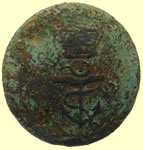 |
|
| c19thC Saxon harness cheek piece | Huge Corporation button | Royal navy button Legend Royal ***** |
|
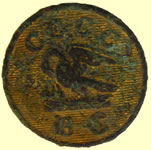 |
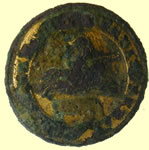 |
 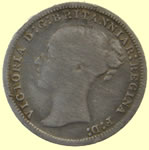 |
|
| 19thC livery button | 19thC hunting button | 1874 Victoria milled silver three pence | |
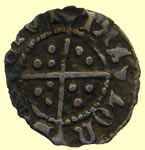 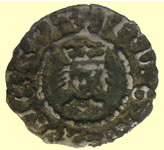 |
  |
||
1485 Henry VIII hammered silver half penny - 'brush hair' - wide cleft cross Open crown type Obv hENRIC DI GRA REX Rev CIVI/TAS/LON/DON - London mint |
1634 Charles 1st hammered copper rose farthing | ||
  |
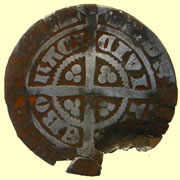  |
||
1204-5 King John hammered silver short cross half penny- Class 5 Obv HENRICVS REX Rev +ABEL.ON. *** Moneyer Abel of London mint |
Don't have time to 'coo'k the crust off this yet to get full ID 14thC Edward III hammered silver half groat Rev CIVI/TAS/EBO/RACI - York mint |
||
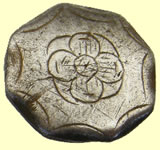 |
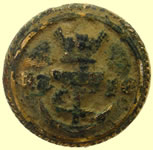 |
 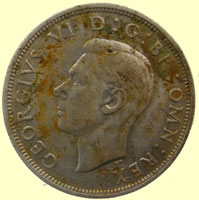 |
|
| 18thC silver button | Royal Thames Yacht club | 1945 George VI milled silver half crown (30 pence) | |
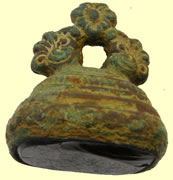 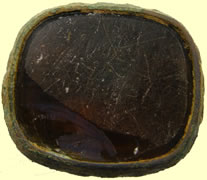 |
 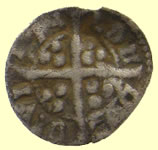 |
||
| Blank Georgian fob seal | 1300-10 Edward 1st hammered silver farthing- Type 28 Obv EDWARDVS REX Rev CIVI/TAS/LON/DON - London mint |
||
 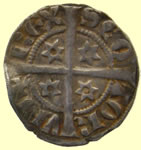 |
|||
Stunningly crisp example of a 1280 1286 Alexander III Scottish hammered silver penny - 2nd Coinage Stars have 6 points Ref SA3HD-005 Obv ALEXANDER DEI GRA Rev SCO/TOR/VM+/REX |
|||
 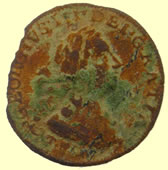 |
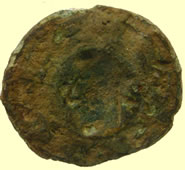 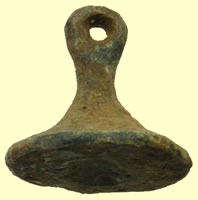 |
||
| 1761 George II English jetton | 13th seal matrix - needs cleaning | ||
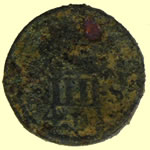 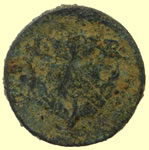 |
 |
||
Scottish made 1634 Charles 1st coin weight - These weights have the initals of James 1st but were made under Charles 1st Obv IIIIs beneath a crown Rev Thistle IR |
17thC lead token | ||
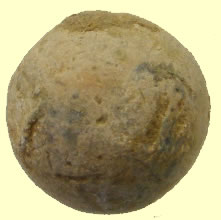 |
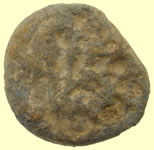 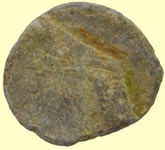 |
||
| 16thC Tudor stone caronade shell | Roman lead token | ||
  |
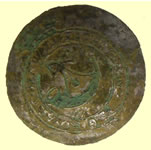 |
 |
|
| 1158 -1189 AD Henry II hammered silver penny ' Tealby' cross and crosslet type | 1881 Royal Cornwall Light Infantry button Infantry regiment of the British Army from 1881 to 1959. Its lineage is continued today by The Rifles. |
French Napoleonic 4th Regiment of the line | |
|
|||
| Animal headed medieval barrel lock ? | |||
 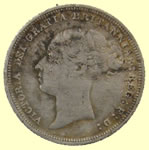 |
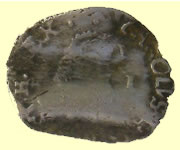 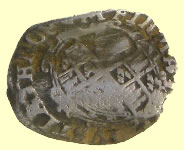 |
||
| 1885 Victoria milled silver sixpence | 1641-3 Charles 1st hammered silver penny - mintmark 2 dots 'triangle and circle' King had left London and Parliament stuck these coins |
||
 |
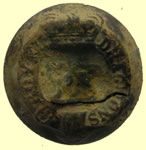 |
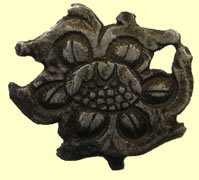  |
|
| 1710 Charity button | Royal Dragoons button | Victoria silver jewelry fragment | |
Medieval badges Ref Mitchiner p244 939 - 941
|
|||
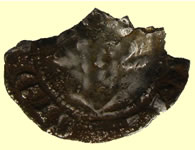 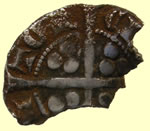 |
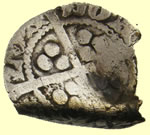 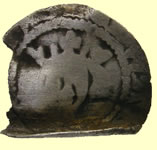 |
||
1279 Edward 1st hammered silver penny Obv **ANGL DNS ** Rev CIVI/TAS/CAN/TOR - Canterbury mint |
1279 Edward 1st hammered silver penny Obv EDWAR ** Rev CIVI/TAS/LON/DON - London mint |
||
 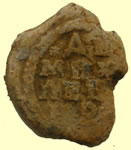 |
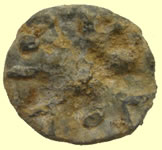 |
||
| 1777 Rusiian bale seal | 15thC lead token | Roman buckle tongue | |
 |
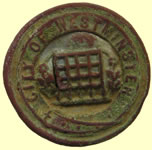 |
 |
|
| Saxon mount | City of Westminster London button | 19thC Royal Engineers button | |
 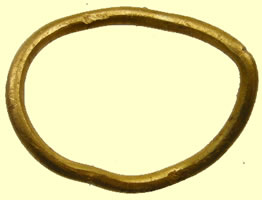 |
|||
Plain medieval gold ring - reported as treasure to museum 2.37g, 22.16mm |
|||
 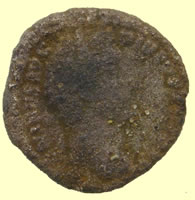 |
|||
2ndC Roman silver coin - cooking it - sent for ID From my first glance at the profile of the portrait, I said to myself "Hadrian", but the legend - which is semi-readable - appears to say Antoninus Pius at first glance - but on magnification, it seems more likely to be one of Marcus Aurelius' obverse legends (Antoninus Pius was Aurelius' adoptive father and the name part of his official title) - until I look at it in a different rotation - now I'm back to thinking it's Antoninus Pius Basically, I'm really curious to see what comes out of the cooker - this is too vague to tell, so far. Mark |
|||
  |
 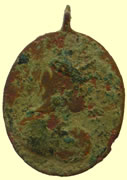 |
||
| George III half guinea gaming token | 19thC religious pendant | ||
| Started new finds page April 2012 to speed up load times | |||
See more finds on the 2012 Feb Finds Page 1 |
|||
 |
|||
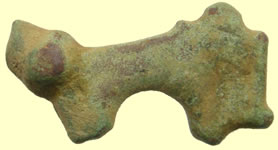

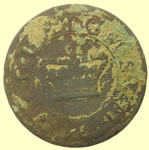
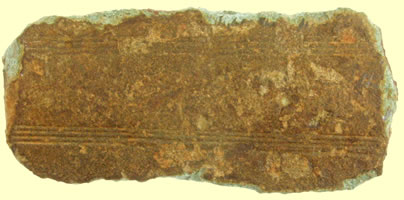

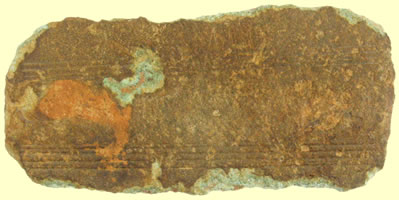

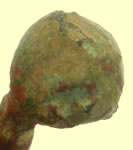

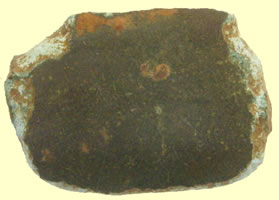

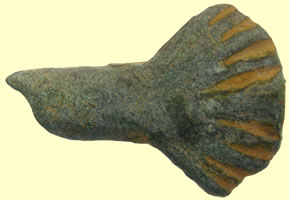
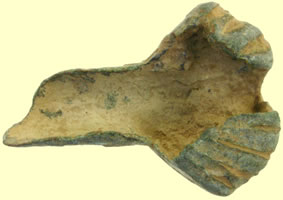

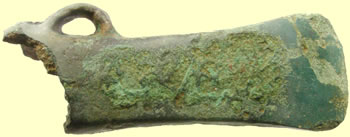
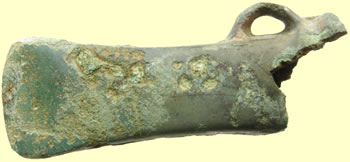

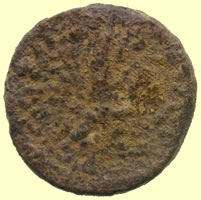
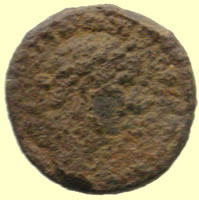
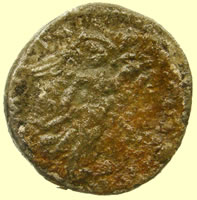
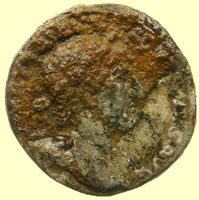
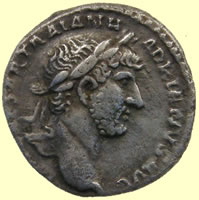
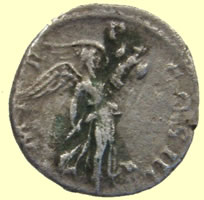
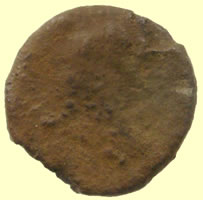
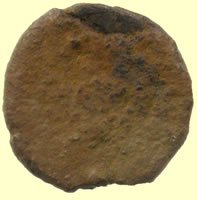
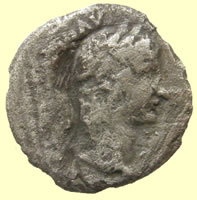
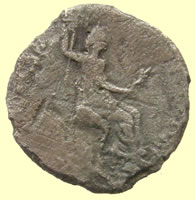
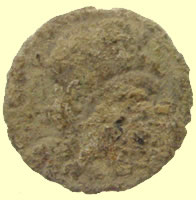
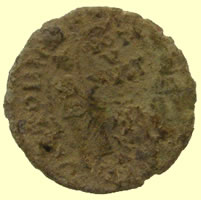
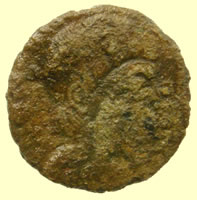
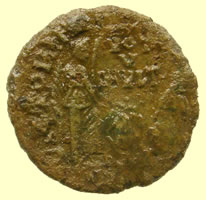
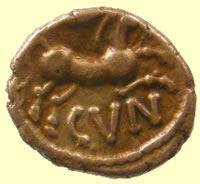
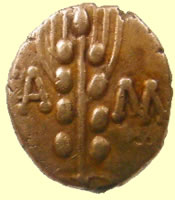



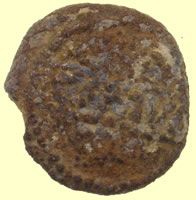
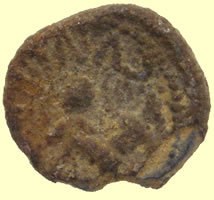
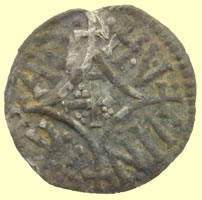
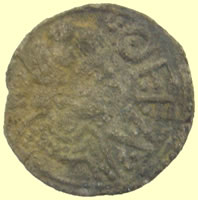



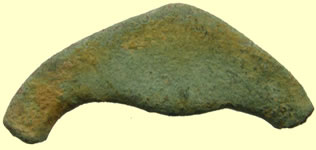
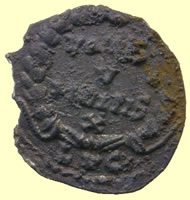
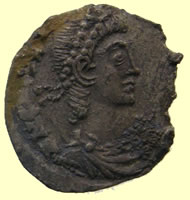
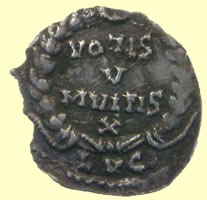
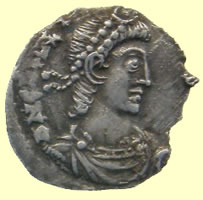
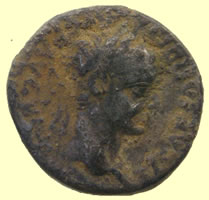
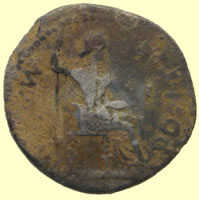
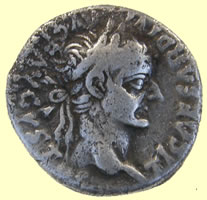
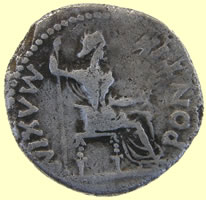
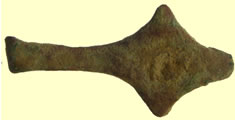
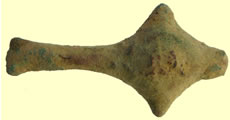
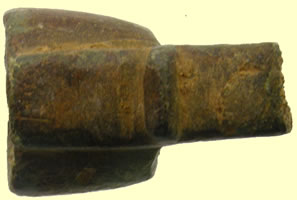
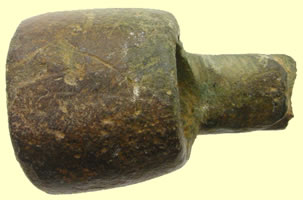
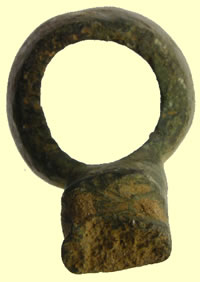

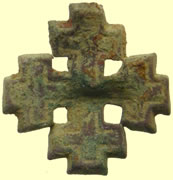
 'A badge for a Knight of the Order of the Holy Sepulchre in bronze and dating somewhere around C13/14th possibly very slightly later . This is a very scarce item and it relates to The Equestrian Order of the Holy Sepulchre of Jerusalem being a Catholic chivalric order of Knighthood that traces its roots to Godfrey of Bouillon, principal leader of the First Crusade. According to reliable sources in the Vatican and Jerusalem, it began in historical reality as a mixed clerical and lay confraternity (association) of pilgrims which gradually grew around the most central of the Christian holy places in the Middle East, the Holy Sepulchre or the tomb of Jesus Christ.This would have been a pin for a member of the order , there is a mark on the reverse where the original pin would have been fixed '
'A badge for a Knight of the Order of the Holy Sepulchre in bronze and dating somewhere around C13/14th possibly very slightly later . This is a very scarce item and it relates to The Equestrian Order of the Holy Sepulchre of Jerusalem being a Catholic chivalric order of Knighthood that traces its roots to Godfrey of Bouillon, principal leader of the First Crusade. According to reliable sources in the Vatican and Jerusalem, it began in historical reality as a mixed clerical and lay confraternity (association) of pilgrims which gradually grew around the most central of the Christian holy places in the Middle East, the Holy Sepulchre or the tomb of Jesus Christ.This would have been a pin for a member of the order , there is a mark on the reverse where the original pin would have been fixed '